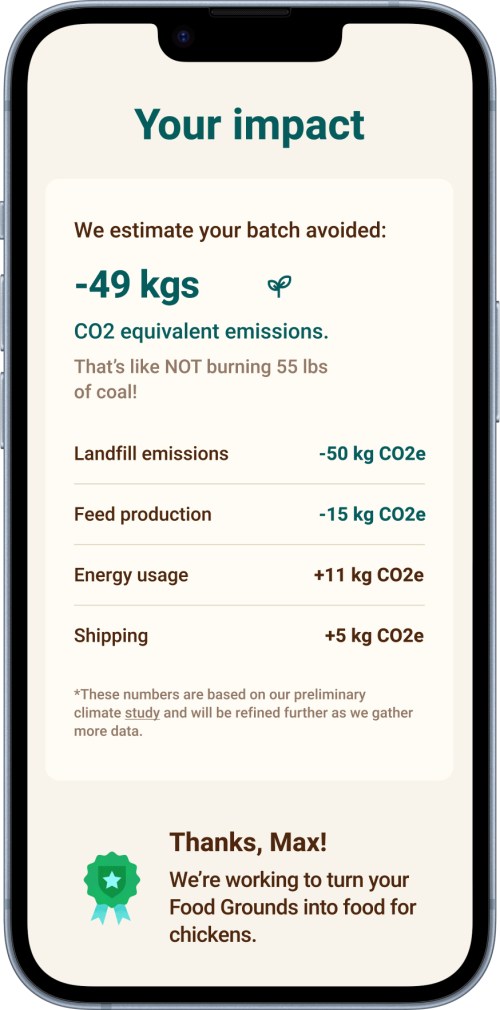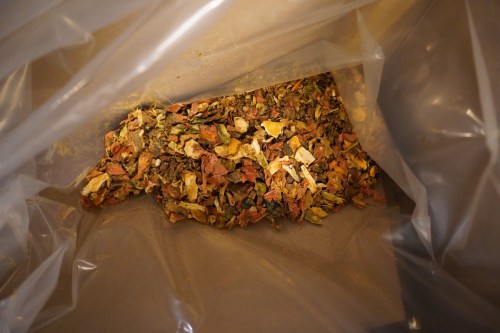This Chic Bin Turns Kitchen Scraps Into Chicken Feed Helping Reduce Food Waste—And I Got To Be One of the First To Try It
Discover how the Mill kitchen bin can help reduce the impact that food waste has on the environment with its unique business model.

What happens to trash once you throw it away is usually an afterthought for most of us—you toss it in a bin, and then it’s (seemingly) gone forever. But, in truth, it’s really not. Most trash will take weeks, if not months, to decompose in a landfill. Or worse, plastics—that aren’t correctly recycled—can contribute to the ever-growing Great Pacific Garbage Patch, which covers an estimated 1.6 million square kilometers of the ocean, an area twice the size of Texas.
Experts in This Article
co-founder of Mill
One company hoping to make trash, well, a little less wasteful is Mill, which launched earlier this year. This first-of-its-kind, all-inclusive, food-recycling bin transforms food scraps (think peels, bones, stalks, and even forgotten leftovers) into safe-to-eat food for chickens. The company was founded by Matt Rogers, co-founder of the smart thermostat Nest, and Harry Tannenbaum, an early Nest team member. Its first product features some of the most innovative technology to create a better kitchen experience (no more stinky trash) while offering folks an easy way to make a dent in climate change.
I had the chance to catch up with Tannenbaum to learn more about how he and Rogers are closing the loop on food waste. Plus, I took a Mill kitchen bin for a spin and was literally mind-blown by how simple (and good for the conscience) transforming kitchen scraps can be… thanks to their state-of-the-art technology, of course. The inside scoop ahead.
How does the Mill kitchen bin work?
Consider Mill a five-step, mostly hands-off activity. First, you’ll need to sign up for a Mill membership (which can be billed annually for $396 or monthly for $45). This includes the high-tech kitchen bin, materials to ship the “milled” waste to farms, and a personalized impact tracking system. Once the Mill is up and running (which can be controlled via a mobile app) comes the fun part: Filling up the bin with a wide range of kitchen scraps. Seriously, it’s not a picky eater whatsoever. The Mill turns everything from chicken bones, dairy, and vegetable scraps into nutrient-rich food grounds by drying, shrinking, and “de-stinking” the food overnight.
Once the bin is full (which can take several weeks), the food grounds should be emptied into the pre-paid shipping boxes and scheduled for pickup by the United States Postal Service (USPS) via the app. From there, the folks at Mill do the rest and work to turn the food grounds you provide into safe, edible chicken feed. Easy enough, right?

How the Mill helps reduce food waste
Coming up with an idea that’s trash isn’t typically what most innovators are going after, but that’s exactly what motivated the team behind Mill. But according to Tannenbaum, food is the number one category that makes up the landfills in the United States, most of which comes from households—63 percent of it to be exact. Yet less than four percent of wasted food from homes is composted, and according to the Environmental Protection Agency (EPA), over one-third of the food grown in the U.S. goes unused. We’ll let that sink in.
“No one likes throwing away food. It doesn’t feel good, it’s icky, and it’s gross,” Tannenbaum says. “But the thing that hit us on the head was how much food we really waste.”
In order to make Mill a viable product, he and his team had to solve for one major question: How do you create a really seamless process, such that it makes doing the right thing easier? To that end, Tannenbaum spent most of his time designing an enjoyable experience for customers and their trash. “We wanted to ensure that the Mill was really user-friendly, that it looked good in your kitchen, but also that it was a good guest in your home that eats anything that you can’t eat and takes a long time to fill up,” he says.
Why chicken feed and not compost
Beyond making the Mill user-friendly and aesthetically pleasing, Tannenbaum was also tasked with building (and closing) a whole new loop—turning trash into chicken feed. This may seem like a less obvious choice than a more well-known alternative for food waste—compost—but Tannenbaum says there were several reasons Mill decided not to go that route.
“We’re really inspired by composting in what we’re doing,” he says. “But the thing that’s tough about composting is that you need time, space, and some skills to make it happen. Also, you may live somewhere where you have cold winters that make it hard to compost in your backyard.”
Now, think of that on a larger scale. To put things into perspective, Tannenbaum notes that composting large quantities of food is difficult for municipalities, too. (Remember, less than four percent of food is actually composted.) “The vast majority of it is disposed of in landfills where you get methane gas, or it’s incinerated, which is kind of upsetting to think about just burning food,” he says.
According to the EPA, the worst thing you can do for food is send it to a landfill. “Instead, we want to conserve food as food, utilizing the energy and nutrients that went into growing and processing the food we eat so we can keep it in the food system by feeding it to animals. This aligns with the EPA’s food recovery hierarchy,” Tannenbaum says. Turning food scraps into animal feeds sits right below feeding hungry people with extra food and reducing surplus food in the first place.
Although, it’s necessary to address that the chicken industry as a whole comes with its own set of environmental concerns. Research shows that poultry production and waste by-products are linked to ammonia, nitrous oxide and methane emissions, and, thus, have an impact on global greenhouse gas emissions, as well as animal and human health.
On that note, Tannenbaum has focused on supporting farmers that have environmentally-friendly practices in place. “We’ve been really deliberate and thoughtful about the partners we want to work with and we want to make sure that we’re finding farmers that are geographically proximate to where we’re processing the material,” he says. “What’s been really cool is that there have been tons of folks that are super excited about this feed ingredient because of the positive impact it can have on their operations, both in terms of the health of the eggs that they’re growing and also their emission profile.”
Additionally, Tannenbaum notes that all things considered, even chicken waste can be put to good use. “If you were to extend the loop, you have food that we don’t eat, and the rest of that food could go to the chicken, and then the chicken eats that and makes chicken poop and then that’s great to put on soil,” he says. In his purview, he explains that by using food that’s still “good” to feed chickens that support soil health with manure, this could ultimately help grow more food in the long run to feed humans, chickens, and so on.
So, what happens with the food grounds once they’re shipped?
After the food scraps have turned into grounds, and you’ve collected enough to fill up your pre-paid shipping containers, they’re sent back to Mill’s central facility, where they carry out additional decontamination steps, including inspecting, screening, and heat-treating the material. “Something really cool is that we can provide feedback to users if we see something in there that probably shouldn’t have been there,” Tannenbaum says. “All of this is done in service of making this a safe and nutritious chicken feed ingredient.”
From a big-picture perspective, according to the company’s calculations, if Mill gets into 20 million homes in the U.S., it can supplement feed for approximately 668 million chickens (about seven percent of chickens in the U.S.).

How many emissions can using the Mill really spare the environment?
Now, let’s get into the nitty-gritty. It’s important to address that there are emissions associated with producing and using the bin. There are also some emissions when it comes to shipping the grounds back. However, all those mentioned above are counteracted by the methane emissions avoided from landfills and with growing and producing chicken feed that Mill is helping to offset. “On an annual basis, we save an estimated half-ton of emissions per household per year,” Tannenbaum says. For context, when that food rots, the methane it produces is 80 times more potent than carbon dioxide (the leading, human-caused greenhouse gas that impacts global warming).
My experience using the Mill
I had the opportunity to test out a Mill for several weeks, and my perspective on food waste has changed for the better. After getting my membership all squared away, the Mill was delivered in a giant cardboard box to my doorstep. Warning: It’s extremely heavy but has instructions right on the packaging to help make the unboxing much easier.

Once the Mill was settled in its new home, I had a chance to marvel at its beauty. From looks alone, the ultra-sleek-looking bin isn’t an eyesore, unlike most other trash receptacles. In fact, it’s very aesthetically pleasing and adds a touch of elegance to any kitchen.
The next order of business was getting my bin up and running and connecting it to the app, which was extremely user-friendly and made tracking my usage easy. It’s also a great resource for knowing what you can and can’t put into the Mill. Note: The Mill doesn’t take large animal bones, seafood shells, large amounts of liquid, grease, or oils, large amounts of sugary foods, compostable plastics, packaging, or other containers, houseplants, flowers, or medications.
Then, the fun part: Filling ‘er up. Over the course of a few weeks, I would simply toss any Mill-approved scraps into the bin, and to my amazement, come morning, they would become shriveled-up versions of the food turned into small, dried grounds. (I preset my bin to do the drying and grinding part overnight.) The best and most shocking bit of it all is that there’s absolutely no scent or odor emitted from the grounds, even if they sat there for over a week. This made transferring the grounds once the bin was full to the prepaid box a completely not-gross activity.

Aside from the practicality of it all, one of my biggest takeaways from using the Mill was the peace of mind it gave me regarding any food waste I incurred. Typically, I feel an overwhelming sense of guilt throwing away any type of food (rightfully so). Yet, I’m human, and as much as I hate to admit it, it happens. However, the Mill offers a closed-loop opportunity to prevent kitchen waste from entering landfills or other anti-climate-friendly circles and puts it to good use instead.
That said, although Mill is looking to outsmart trash, they aren’t necessarily the end-all-be-all of the much larger food waste issue at hand. At least not yet. However, they’re certainly a step in the right direction and can help kick us off on the small, but mighty impact we can make from the comfort of our homes.
An RD’s recommendations for eating more sustainably:
Sign Up for Our Daily Newsletter
Get all the latest in wellness, trends, food, fitness, beauty, and more delivered right to your inbox.
Got it, you've been added to our email list.










